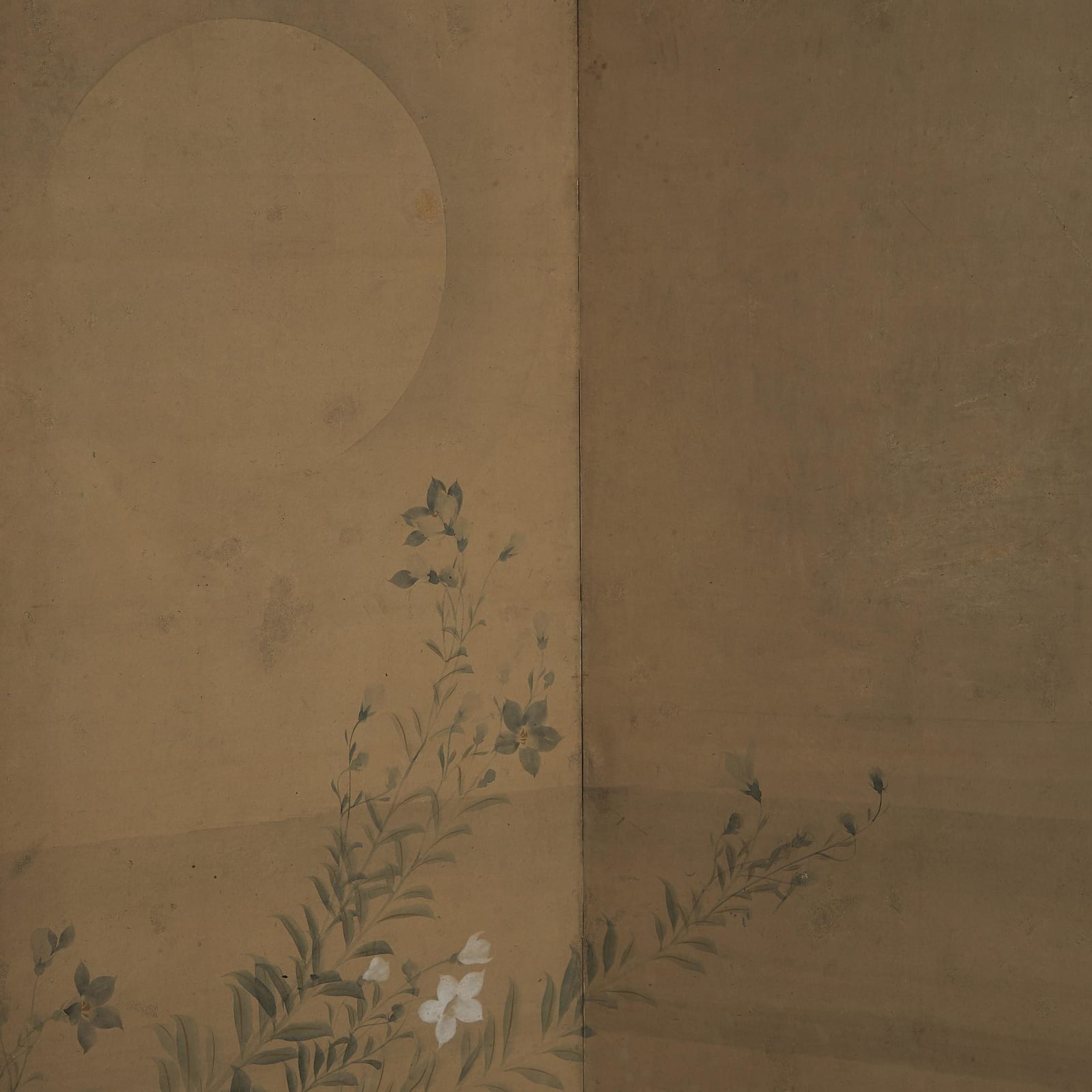Sakai Hōitsu (1761–1828)
Autumn Flowers under a Full Moon
Color on paper, single six-panel folding screen
Seals: Bunsen, Bunsen
114.8 x 256.6 cm (overall)
Further images
Not only the typical autumn flowers and grasses such as eulalia grass, maiden flowers, and Chinese bell flowers, but garden burnet and nutgall tree can be seen in this screen. The motif of garden burnet is commonly adopted in both Hoitsu’s Moon and Autumnal Grasses (in the form of folding fan) in the Tokyo National Museum and his successors such as Suzuki Kiitu’s works. The representation of nutgall tree here is comparable to that in Autumn Flowers and Grasses in Joun-ji Temple in Gunma Prefecture.
Several other large-scale works of the same subject of moon and autumn grasses by Hoitsu, which vividly display rich colors and the moon tinted silver on a gold-leafed background, show a fluent use of the Rinpa idioms. In contrast, the moon and grasses here is layered with thin ink wash; the strikingly vivid colors which Rinpa masters typically use are never found.
Concerning the signature on this work, the character of “Ho” is close in style to his early signature, “Ho-itsu,” which first appeared around 1803. Predating this signature, in Moon and Autumn Grasses in the MOA Museum of Art, the distinctive tarashikomi technique is clearly recognized on the grasses; nevertheless, this technique is never shown in this screen. Though the Rinpa elements are found again in Hoitsu’s later works of moon and autumn grass, it is more than just a succession to the orthodox Rinpa style. It is perhaps because Hoitsu once departed from the Rinpa style, and returned with a somewhat urban sophisticated delicacy seen in this screen.
Sakai Hoitsu (painter, haiku poet; 1761–1828)
Also known as Kishin, Keikyo-dojin, Oson, Uge-an, Toryo, etc.
Painter and haiku poet in late Edo period. Younger brother of the lord of Himeji domain, Sakai Tadazane. Adopted son of the 18th head priest of Higashi honganji, Monnyo Shonin. His real name is Tadanao. Learned shasei (direct observation from life) technique from So Shiseki, and studied ukiyo-e painting and techniques from the Kano, Tosa, and Maruyama schools. Eventually admired Ogata Korin. Added sensitive and emotional expression to Rinpa school’s decorativeness, which was established as his own style.
Several other large-scale works of the same subject of moon and autumn grasses by Hoitsu, which vividly display rich colors and the moon tinted silver on a gold-leafed background, show a fluent use of the Rinpa idioms. In contrast, the moon and grasses here is layered with thin ink wash; the strikingly vivid colors which Rinpa masters typically use are never found.
Concerning the signature on this work, the character of “Ho” is close in style to his early signature, “Ho-itsu,” which first appeared around 1803. Predating this signature, in Moon and Autumn Grasses in the MOA Museum of Art, the distinctive tarashikomi technique is clearly recognized on the grasses; nevertheless, this technique is never shown in this screen. Though the Rinpa elements are found again in Hoitsu’s later works of moon and autumn grass, it is more than just a succession to the orthodox Rinpa style. It is perhaps because Hoitsu once departed from the Rinpa style, and returned with a somewhat urban sophisticated delicacy seen in this screen.
Sakai Hoitsu (painter, haiku poet; 1761–1828)
Also known as Kishin, Keikyo-dojin, Oson, Uge-an, Toryo, etc.
Painter and haiku poet in late Edo period. Younger brother of the lord of Himeji domain, Sakai Tadazane. Adopted son of the 18th head priest of Higashi honganji, Monnyo Shonin. His real name is Tadanao. Learned shasei (direct observation from life) technique from So Shiseki, and studied ukiyo-e painting and techniques from the Kano, Tosa, and Maruyama schools. Eventually admired Ogata Korin. Added sensitive and emotional expression to Rinpa school’s decorativeness, which was established as his own style.





